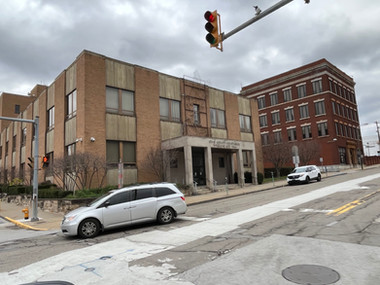West Virginia - Not the future they expected
- randyjoss
- Nov 21, 2022
- 4 min read

It's a mystery why certain places seem to reach out and ask you to visit, as if there were a string connecting you to the place. Sometimes we feel that with the Sierras, or Hayden Lake, and I guess we all understand the pull from those sorts of places, but West Virginia was not one we'd anticipated.
From Cleveland we headed southeast to Youngstown and then straight south down to East Liverpool so we could follow the Ohio River down to Wheeling, West Virginia.
At one time, the Ohio Valley was the beating heart of American Industry. In fact, at the end of the 1800's Wheeling claimed to be the "richest city per capita in America". It became the world's center for production of iron nails and from 1900 to 1940, the city grew by 50%. Unfortunately, after the war Wheeling began its decline and shrank just as fast as it grew. We ate and toured and watch a minor league hockey game. It's clearly a city with pride and with a core of folks working hard to show off that community spirit.
. . . But, at the same time, it's hard not to take a step without being reminded of the hard times that Wheeling has seen (and continues to see). Partly it's the factories, both open and closed, the boarded up storefronts, and the cracked & closed streets (yes, just closed), but it's also just the lack of people on the streets. Neither Saturday night, nor Sunday morning around the churches. It just seemed either abandoned, or, more likely (?), just too big for the number of people that still live there. Even the beautiful, well cared-for buildings almost don't look inhabited.
Imagine being born into the 1990's heyday of boom town Silicon Valley. How would you feel if during your 80 year lifetime you watched your hometown lose the vast majority of its major employers and 60% of its population? That story is played over and over and over again in the Ohio Valley. Even the big employers that are still left along the river continue to struggle. We passed one coal fired electrical generating plant that's already been slated to close as the company tries to move to cleaner energy. Here's a great, great Washington Post story from 1980 about neighboring Youngstown, Ohio. It's called "The Heartbreak of Ohio's Steel Valley". If you're interested in the seeds of the rural/Trumpian anger at the world and the Democratic party, you might really find it interesting.
After Wheeling, we cut across Pennsylvania and down to Morgantown, WV, home of West Virginia University. There, we decided to take a break from Doris and shacked up in the Hotel Morgan right downtown and near the University. We were hoping to find a bright spot in a university town, but even that didn't work out. While Morgantown has it's highlights, it's also one of the very few towns since we left California where we've seen significant numbers of homeless people. No idea why.
There are some really gorgeous, old buildings in Morgantown. The hills and the land are just as captivating as anywhere. And, it's the hometown of Don Knotts! Which is cool. But it's a classic case of a city with a directionless downtown core -- boarded up shops and dilapidated old storefronts sitting next to, for example, a custom leather shop selling $400 jackets and $600 duffle bags. While, on the outskirts of town sits one of the largest strip malls we've ever seen. There are just acres and acres of Walmart and Buffalo Wild Wings and every other store you can imagine all perched on this beautifully flattened hilltop . . . and facing AWAY from a gorgeous view of the valley and the downtown area. We actually drove in behind a Chinese restaurant and sat for a while looking out at the sunset twilight stretching out over the river and the town. It was really really lovely, but we were BEHIND the restaurant, parked among the garbage cans. Joan just kept saying over and over again "How could they build ANYTHING up here and make it facing away from this view??"
We liked Morgantown. It really was a nice hotel and the people were particularly kind and welcoming, but we couldn't escape the feeling that the hardships of the last 60 years had left scars that it just couldn't erase.
Thought for the day:
We had long discussions while in Morgantown and on our drives through West Virginia about how incredibly different this part of the world is from California. I think from now on, everytime we have an idea for a policy proposal we like, or a criticism of someone else's policy ideas, we'll pause to think about West Virginia and the Ohio River Valley. For maybe 60 years this was a region on top of the metaphorical world. And then, for 60 years after that, it's been a (too frequently) forgotten corner of the bottom of the world. We had the GI bill to try to help returning soldiers and we had affirmative action to try to lift up minority education and businesses after years of discrimination. For parts of the West Virginia like Wheeling and Youngstown and East Liverpool and Steubenville, did we ever consider something similar for them?


































































Comments